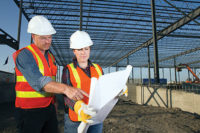• Utilities industry total recordable cases 2013 – 2.1 per 100 full-time workers
(3.3 cases per 100 workers for private industry)
• Cases with days away from work, job transfer or restrictions 2013 – 1.1
(1.7 cases per 100 workers for private industry)
• Fatal injuries – 3,929 in private industry in 2013
23 fatalities in the utilities industry in 2013
30% occurred on the roadway, 13% due to being struck by an object or equipment
OSHA Utility Industry Enforcement Data
152 total citations / 60 total inspections / $300,458 total penalties
Frequently cited OSHA standards for the utility industry Oct 2013 – Sept 2014
- Respiratory protection
- Hazard communication
- Occupational noise exposure
- Duty to have fall protection
- Specific excavation requirements
- Process safety management of highly hazardous chemicals
- Electrical power generation, transmission and distribution
Utility industry safety and health major issues
Environmental, health and safety management systems
Risk management
Emergency preparedness and response
Contractor safety
Community relations, public safety and stewardship
Earthquake and natural disaster protection (nuclear power plants)
Safe operations and spent fuel management (nuclear power plants)
Pipeline safety
Fleet safety
Lone worker safety
American Gas Association Safety Culture Statement
COMMITMENT BY MANAGEMENT: A positive safety culture begins with the organization’s top leaders. Management must emphasize and demonstrate that the safety of employees, customers, the public and our pipeline systems is a value that is paramount. All decisions must take into account the importance of safety. For example, production, cost, and schedule goals should be developed, communicated and implemented in a manner that demonstrates that employee, customer, public and pipeline safety is an overriding priority.
SPEAK UP: A positive safety culture also means that every individual communicates safety concerns without fear of retaliation. Open and honest communications across all levels of an organization, and to all key stakeholders, are necessary for a positive safety culture.
IDENTIFY HAZARDS: A positive safety culture expects its employees and those providing services to identify hazards and act on them. Any potential situations that could affect employee, customer, public, or pipeline safety should be promptly identified, fully evaluated and appropriately addressed. Identified hazards and near miss incidents should also be shared across the organization so that others may learn of a possible hazard.
MANAGE RISKS: A positive safety culture expects employees to understand the inherent risks presented by their activities serving customers and operating natural gas assets. These risks must be effectively managed through appropriate programs and management systems designed to safeguard the public as well as employees and contractors.
PLAN THE WORK, WORK THE PLAN: A positive safety culture encourages employees and those providing services to take the time to assess a job site and the work to identify the steps that must be performed to achieve the desired result safely, and then implements that plan in fulfilling any work activity.
PROMOTE A LEARNING ENVIRONMENT: A positive safety culture is one within which everyone is encouraged to learn new methods and processes to improve safety. Ongoing monitoring of safety programs and analyzing incidents provide the basis for a continuous improvement process.
PERSONAL ACCOUNTABILITY: A positive safety culture is one where each individual takes responsibility and accountability for safety in their day-to-day work activities. This means individuals should focus on what more “I” can do to ensure that we, and our fellow employees, are complying with all safety standards applicable to any particular task. Working safely and keeping our pipeline systems, customers and the public safe means committing to the safety culture for ourselves, our family, our friends, our companies and our community.
Falls – from utility poles, etc.
Electrocution – contact with power lines, etc.
Struck by objects or equipment injuries
Sprains, strains and fractures
Environmental stress
Workplace stress and fatigue (12-hour shifts, etc.)
Wicked weather – extreme cold, extreme heat, hurricanes, snow storms, torrential rain, wind storms
Dog bites (meter readers)
Insect bites
Lyme disease
Trenching cave-ins
Fire
Noise
Confined spaces
Lockout/tagout of energized equipment
Distracted driving
Other driving hazards
Arc flash explosion exposures and other uncontrolled releases of electrical, mechanical and other types of hazardous energy
Natural gas and combustible dust explosions
Construction hazards – crane operation, work at height, weather, trenching, etc.
Radiation exposure (nuclear power plants)
San Bruno, Calif., 2010 pipeline explosion
On September 2, 2014, California regulators imposed $1.4 billion in penalties against Pacific Gas & Electric for a 2010 gas pipeline explosion in a San Francisco suburb that killed eight people.
PG&E issued a statement saying it believed a penalty is appropriate. "Since the 2010 explosion of our natural gas transmission pipeline in San Bruno, we've been dedicated to re-earning the trust of our customers and the communities we serve," the utility said in the statement. "We are deeply sorry for this tragic event."
The utility also said, "We are accountable and fully accept that a penalty of some kind is appropriate.”
The utility said it has hired gas experts to help boost its safety and reliability.
The commission previously ordered PG&E to pay $635 million for pipeline modernization after the Sept. 9, 2010, blast. A 30-inch natural-gas transmission line installed in 1956 ruptured, destroying more than three dozen homes. A 2011 investigation by the National Transportation Safety Board concluded that the rupture occurred in a weak weld in a pipeline that PG&E records had shown as being smooth and unwelded. PG&E neglected to shut off natural gas feeding the fire until 95 minutes after the blast, the federal investigators said.
The National Transportation Safety Board said among the questions it investigated in the Sept. 9 explosion is whether workers at a PG&E pipeline-monitoring terminal in Milpitas, Calif., were fatigued or poorly trained. Eight days after the blast, the federal Pipeline and Hazardous Materials Safety Administration moved to speed up adoption of a rule to ensure that workers doing similar jobs at companies across the country are well-trained and rested; especially because many of those workers put in 12-hour shifts.
Making sure utility employees aren't too tired or otherwise incapable of managing the computerized data they see "is absolutely important," Shamin Sharoki, president of Houston-based Consipio, which advises gas companies on such matters, told the Los Angeles Times. "If somebody is not trained, it could be very dangerous. If they don't properly respond to an alarm situation, it can cause an explosion. It can cause leaks. The damage could be very large."


